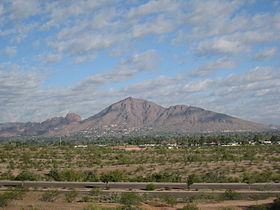Camelback Mountain
| Camelback Mountain | |
|---|---|
 |
|
| Highest point | |
| Elevation | 2,706 ft (825 m) NAVD 88 |
| Prominence | 1,334 ft (407 m) |
| Coordinates | 33°30′53″N 111°57′42″W / 33.514723847°N 111.961604211°WCoordinates: 33°30′53″N 111°57′42″W / 33.514723847°N 111.961604211°W |
| Geography | |
| Location | Maricopa County, Arizona, U.S. |
| Parent range | Phoenix Mountains |
| Topo map | USGS Paradise Valley |
| Geology | |
| Mountain type | granite, sandstone |
| Climbing | |
| Easiest route | Echo Canyon trail, Cholla trail |
Camelback Mountain (O'odham: Cew S-wegiom) is a mountain in Phoenix, Arizona, United States. The English name is derived from its shape, which resembles the hump and head of a kneeling camel. The mountain, a prominent landmark of the Phoenix metropolitan area, is located in the Camelback Mountain Echo Canyon Recreation Area between the Arcadia neighborhood of Phoenix and the town of Paradise Valley. It is a popular recreation destination for hiking and rock climbing.
A cave discovered on the north side of Camelback mountain indicates that it was used as a sacred site by the prehistoric Hohokam Culture before they abandoned the area in the 14th century.
In January 1879, United States President Rutherford B. Hayes included Camelback Mountain as part of a one million acre (4,000 km²) reservation for the Salt River Pima and Maricopa American Indian tribes. Six months later, at the behest of Charles Poston, the Arizona Territorial Legislature reversed the decision in order to ensure the primacy of the 5000 non-Indian area residents as well as their continued access to Salt River water.
Efforts to protect Camelback Mountain as a natural preserve began in the early 1910s. However, by the 1960s, nearly all of the area had been sold to private interests. Federal and state authorities attempted to stop development above the one thousand and six hundred feet level. They failed to halt development and in 1963 efforts to arrange a land exchange failed in the Arizona State legislature. In 1965, United States Senator Barry Goldwater took up the cause and helped to secure the higher elevations against development. The area became a Phoenix city park in 1968.
...
Wikipedia

